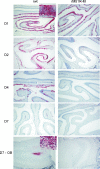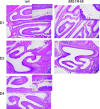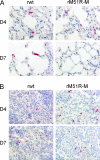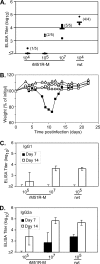Immune response in the absence of neurovirulence in mice infected with m protein mutant vesicular stomatitis virus
- PMID: 18614644
- PMCID: PMC2546904
- DOI: 10.1128/JVI.00915-08
Immune response in the absence of neurovirulence in mice infected with m protein mutant vesicular stomatitis virus
Abstract
Matrix (M) protein mutants of vesicular stomatitis virus (VSV), such as rM51R-M virus, are less virulent than wild-type (wt) VSV strains due to their inability to suppress innate immunity. Studies presented here show that when inoculated intranasally into mice, rM51R-M virus was cleared from nasal mucosa by day 2 postinfection and was attenuated for spread to the central nervous system, in contrast to wt VSV, thus accounting for its reduced virulence. However, it stimulated an antibody response similar to that in mice infected with the wt virus, indicating that it has the ability to induce adaptive immunity in vivo without causing disease. These results support the use of M protein mutants of VSV as vaccine vectors.
Figures




References
-
- Ahmed, M., S. D. Cramer, and D. S. Lyles. 2004. Sensitivity of prostate tumors to wild type and M protein mutant vesicular stomatitis viruses. Virology 33034-49. - PubMed
-
- Ahmed, M., M. O. McKenzie, S. Puckett, M. Hojnacki, L. Poliquin, and D. S. Lyles. 2003. Ability of the matrix protein of vesicular stomatitis virus to suppress beta interferon gene expression is genetically correlated with the inhibition of host RNA and protein synthesis. J. Virol. 774646-4657. - PMC - PubMed
-
- Clarke, D. K., F. Nasar, M. Lee, E. J. Johnson, K. J. Wright, P. C. Calderon, M. Guo, R. J. Natuk, D. Cooper, R. M. Hendry, and S. A. Udem. 2007. Synergistic attenuation of vesicular stomatitis virus by combination of specific G gene truncations and N gene translocations. J. Virol. 812056-2064. - PMC - PubMed
-
- Cooper, D., K. J. Wright, P. C. Calderon, M. Guo, F. Nasar, J. E. Johnson, J. W. Coleman, M. Lee, C. Kotash, I. Yurgelonis, R. J. Natuk, R. M. Hendry, S. A. Udem, and D. K. Clarke. 2008. Attenuation of recombinant vesicular stomatitis virus-human immunodeficiency virus type 1 vaccine vectors by gene translocations and G gene truncation reduces neurovirulence and enhances immunogenicity in mice. J. Virol. 82207-219. - PMC - PubMed
Publication types
MeSH terms
Substances
Grants and funding
LinkOut - more resources
Full Text Sources
Other Literature Sources

